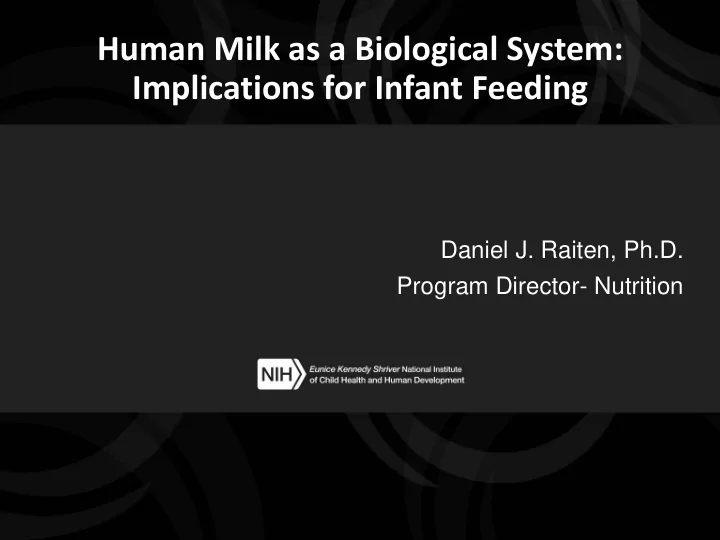

Human Milk as a Biological System: Implications for Infant Feeding Daniel J. Raiten, Ph.D. Program Director- Nutrition
Overview of B-24 Report and P/B-24 for 2020
Results of systematic reviews conducted by NESR to address some of these questions have been published: “P/B-24 Project” Supplement, published April 15 th , AJCN: https://academic.oup.com/ajcn/issue/109/Supplement_7
: Nutritional Ecology of Infant Feeding Factors Affecting Biology and Choice
An Approach to Addressing the Role of Nutrition in MCH Fund research grants using established Research NIH mechanisms, procedures, and GOAL Track policies Improve the Research health of Translation women/mothers and children Work with domestic and international Translational authoritative agencies to translate evidence into practice and policy Track
The Nutritional Ecology: “External” Factors affecting infant feeding practices Diet/Nutrition nutrient exposure/status food/ag systems Health Outcomes Physical/Economic/ clinical/population Social/Behavioral assessment/care Environments program M&E Nutritional Ecology
The Nutritional Ecology: “Internal” Understanding the biology of HM Diet/Nutrition nutrient exposure/status nutrient: nutrient interactions Health Context processes of nutrition; Physical genetics/epigenetics Extra- intra-cellular Xenobiotics environment (drugs/toxins) Nutritional Ecology
Environmental and Biological Context: Factors influencing choice Environment • Social/economic: systems for support Home (who’s the caregiver and who else is involved?) Workplace (is there support for breastfeeding?) Outside home (childcare situation: who else is feeding our babies?) • Cultural practices • Behavioral Attitudes Beliefs • Biology…
Human Milk: Composition and practice • Mode of feeding: is it the bottle or what’s in it? Pump vs breast vs donor/banked human milk. Role of the microbiomes (mother, milk, baby) • Compositional changes over time: Within feeding Over the course of the day Over the course of lactation Implications for complementary feeding: o Nutrition o Bioactives: how long do babies need to be exposed to bioactive components (human milk oligosaccharides [HMOs], etc.) o Can maternal diet/nutritional status affect HMO/bioactive biosynthesis, patterns, composition of human milk? o How do we feed the answers to these questions into current/future dietary guidance for lactating women? • Duration of exclusive and continuous BF: both in terms of nutrition and bioactives
Human Milk A Model System
Human Milk: A poorly understood biological system Microbes Macro- Micro- bacteria/ nutrient nutrients CHO/fat vitamins viruses/ Protein minerals fungi Maternal Factors: Immune Infant Factors: mammary gland Drugs/ factors sucking/reflux/health biology/maternal toxins oral microbiome health/diet/genetics Host cells Hormones Complex Immune, Enzymes epithelial, CHO and Peptides HMO stem Components of Human Milk TIME: GA/of day/over lactation How do we understand this complex system? • Is there cross-talk? • How does the infant interact with this system and mom? • What factors influence mom’s contribution?
HMO: The evolution of understanding… “Only a few decades ago, most experts considered HMO (HMOS) to be an incidental consequence of high concentrations of glycosyltransferases (for glycoprotein and glycolipid synthesis) in proximity to high concentrations of lactose in the mammary epithelium.” Newburg and Grave . Ped Res 2014 Now..
A Research Agenda– Bioactive components of HM • Literally thousands of “non- Human milk oligosaccharides nutritives” in human milk • Abundant and complex • Likely ALL important • Multiple roles, related to • Many are likely inter-related specific structures of specific HMO types Immune cells and immune factors • Personalized to a woman and variable around the globe • Abundant and complex Milk microbiome • Critical for infant and mammary health • Complex • Context-sensitive: personalized • Personalized to a woman and to the individual and variable variable around the globe across the globe and influenced • Related to maternal nutrition by: • Likely important for breast environment health and colonization of maternal health infant GI tract infant health diet
Human milk for low birth weight/preterm infants • Composition of preterm milk: • Fortification? If so, • with what? • Nutrients only? • Bioactives? HMO? Peptides? • Developmental issues re: nutritional and non-nutritional components; infant’s capacity for: Exposure: parenteral/enteral/oral Digestion Absorption Utilization (e.g., LCPUFA, vit B6) • Donor milk: banked: what’s in it? (Raiten et al., Pre-B Report. AJCN, 2016)
Take-home messages… • Factors influencing the biology and choice are a complex interplay of external and internal “ecologies.” • Understanding the biology of lactation and human milk composition requires a ‘systems’ approach that incorporates consideration of the myriad maternal and infant factors involved. • Determining the nutritional needs of both mothers and infants requires a deeper appreciation of nutrition as a biological variable that affects and is affected by health and developmental stage. • We need to translate our knowledge about both biological and environmental factors affecting internal and external nutrition ecologies into: Palatable and accessible messages for consumers to inform decisions about infant feeding. Avoid unintended consequences.
Thank you!
Recommend
More recommend